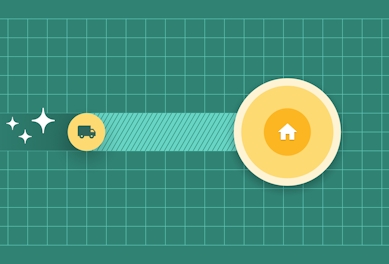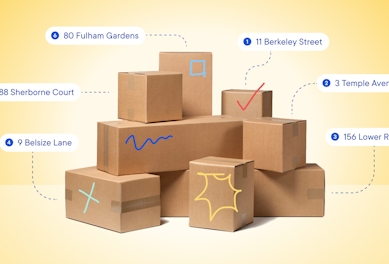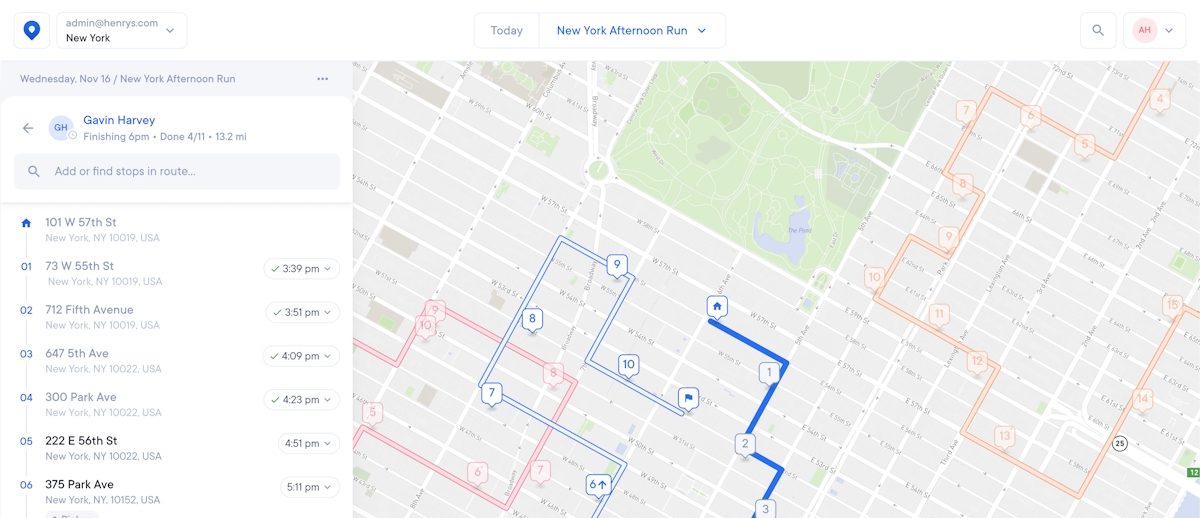Last-Mile Delivery: What It Is and How to Profit
Last-mile delivery is the final step of getting a package to a customer. Find out how to improve last-mile logistics to boost profit.

Last mile deliveries require the most efficient routes. See how Circuit for Teams can help!
Last-mile delivery is the final leg of any delivery journey — it’s the stretch that gets goods from the distribution hub to the customer’s doorstep.
But no matter how great the product is, if it doesn’t make it safely into customers’ hands, it won’t get the appreciation it deserves.
If you’re a retail store, warehouse, or distribution center that delivers products to customers, you should care about your last-mile logistics. It can seriously impact your business operations and long-term success.
Delivery issues like delays and lost packages can lead to customer complaints, negative reviews, and lost business.
And even if a customer is happy with the product they get, delivery issues can overshadow their experience with your company as a whole, negatively impacting the customer experience.
Obviously, customers appreciate it when their deliveries are delivered fast and in good condition.
So, companies that optimize their last-mile delivery processes can boost customer satisfaction, leading to greater brand loyalty and improving their reputation.
But just how can you leverage the possibilities of last-mile delivery?
The key is to create clear delivery processes supported by the appropriate tools for drivers — the people ultimately responsible for a successful final-mile delivery.
Several technologies can help simplify and organize your logistics, both at the organizational level and at the delivery driver level. You can significantly improve last-mile logistics by giving your couriers the information and tools they need to get their work done fast.
This article introduces last-mile delivery, what it involves, and how you can use it to improve operations — and, hopefully, win over more customers and boost profits!
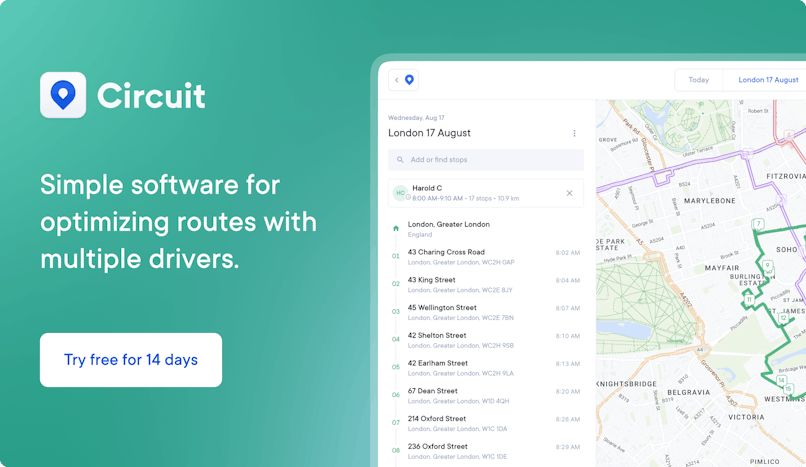
What is last-mile delivery?
You can probably guess what last-mile delivery means, but just in case, here’s the scoop.
Last-mile delivery is a logistics term that refers to the final stage of a product’s journey from a business (like a retailer, distribution center, or warehouse) to the customer.
It literally refers to the last mile that needs to be completed for a product to get into the customer’s hands.
Last-mile delivery is complete when the product has reached the customer’s home, business, or another designated drop-off point, such as a lockbox. On top of getting a package to the customer safely and securely, last-mile delivery should be accurate, fast, and cost-efficient.
Unfortunately, many obstacles stand in the way of good last-mile logistics.
Unpredictable last-mile problems can range from bad weather to delivery vehicle issues. Even one vehicle breakdown can result in hundreds of package delays in just one day!
A lack of planning and transparency can also increase the risk of setbacks, like failed deliveries. For example, if a customer doesn’t know when to expect their package and isn’t home to receive it — but a signature is needed — you have a failed delivery attempt on your hands.
This results in wasted effort and costs, adding to existing delivery costs like driver pay, fuel, and vehicle maintenance.
Unnecessarily ramping up operational expenses? No thanks!
Clearly, poorly executed last-mile logistics spell bad news for companies. But instead of focusing on the negatives, let’s look at the positives — how can efficient last-mile delivery help your company?
Here’s an example of a picture-perfect scenario.
An example of efficient last-mile delivery
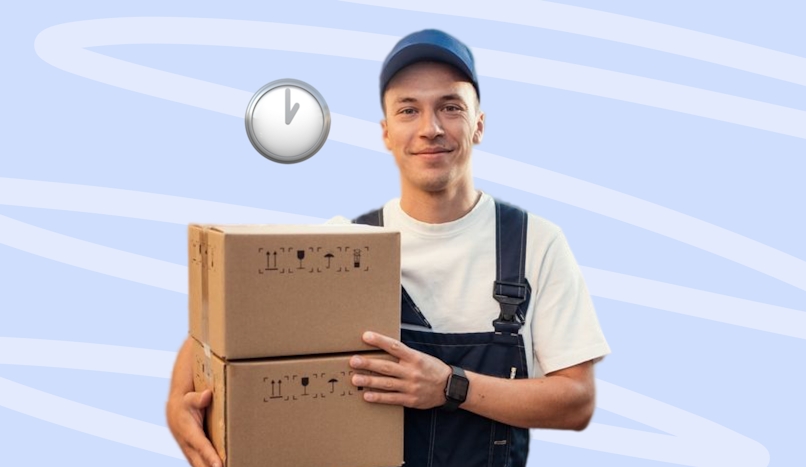
Last-mile delivery should be well-organized, transparent, and timely. Here’s a quick breakdown of what an ideal process might look like.
- New order received and logged: You get a new order and log it in your digital system. At this point, you can also assign the order a tracking number, which the recipient (the customer) can use to check its status, usually through a dedicated website.
- Order assigned to a driver: You assign the order to a designated delivery driver based on the customer’s address and the driver’s route. Logically, drivers should cover areas close to each other so that they don’t have to crisscross a city but can focus on core neighborhoods. Route planning technology like Circuit for Teams can help you plan the most efficient routes.
- Order loaded into the vehicle: Your business loads the physical order into the delivery driver’s vehicle. Ideally, you’ll scan it first so that it can be tracked and located, saving the driver time and trouble. This status update — the fact that the package is now in the vehicle and out for delivery — can also help manage customer expectations.
- Order reaches the customer: The driver follows their designated route — which you’ve optimized for maximum efficiency — to deliver the order. Giving delivery time windows to the customer using route planning software like Circuit for Teams can help make sure they are around to collect their package if needed.
- Order fulfillment confirmed: For you and the driver’s record-keeping — and, of course, the customer’s peace of mind — orders can be confirmed as delivered using a proof-of-delivery feature like what’s included in Circuit for Teams. Examples include the driver taking a photo of the package or getting the customer’s signature.
As you can see, communication and clarity are integral at every step! From planning routes for drivers to sharing delivery time windows with customers, transparency simplifies the process for all involved.
Technology is also critical for effective final mile delivery. Modern tools like Circuit for Teams routing software can simplify delivery organization, improve communication, and minimize the risk of bottlenecks (like lost packages or drivers hitting traffic jams in urban areas).
Who are the top last-mile delivery companies?
If you want to improve your last-mile delivery process, it can help you to see what other logistics companies are doing right.
Here are some of the most respected names in the business and insights into their processes:
- UPS: The United Parcel Service has been in business for over a century (founded in 1907), so it’s safe to say their delivery processes have stood the test of time! This delivery service provider caters to countries all over the world. Although they may be more than 100 years old, they have no trouble keeping up with the times, technologically speaking. Standout features include email delivery status notifications for customers, API integration options, and expanded delivery coverage (for example, on weekends). UPS has also spearheaded innovations like delivery drones and autonomous vehicles.
- FedEx: FedEx is one of the top third-party logistics providers in the logistics industry, operating worldwide. Established in 1971, the company has had decades to perfect its approach to last-mile delivery. Some key takeaways include their advanced tracking solutions, including real-time delivery tracking and regular delivery status notifications for customers. Customers can even use an online delivery manager to modify delivery options, rescheduling or redirecting packages as needed.
- Postmates: Postmates is dedicated to food delivery, bringing restaurant meals to customers’ doors. This app-based service is a prime example of the value of transparency in last-mile delivery, as the app allows customers full visibility of their delivery driver’s status. Postmates also offers delivery within the hour, highlighting the importance of speed in last-mile delivery services.
- Uber Eats: Like Postmates, Uber Eats allows people to have restaurant meals delivered to their homes. It’s also an app-based service, giving customers real-time updates about their orders. Companies interested in improving their last-mile delivery should note how user-friendly the Uber Eats platform is, making it easy for customers and drivers alike to keep track of orders.
- Instacart: Unlike Uber Eats and Postmates, Instacart focuses on delivering grocery store goods to customers, not ready-made restaurant meals. The delivery service app is also a testament to the need for speed in last-mile logistics, as it gives customers the option to have their groceries delivered in as little as two hours. Instacart also shows how combining services can boost business — in this case, having a personal shopper and delivery driver in one.
These are just a few names in the last-mile delivery business. Other delivery solutions include USPS, Amazon Prime, DHL, and Grubhub.
When the field has so many options, the competition is fierce, so it’s critical that your last-mile logistics can keep up.
What is the last-mile delivery problem?
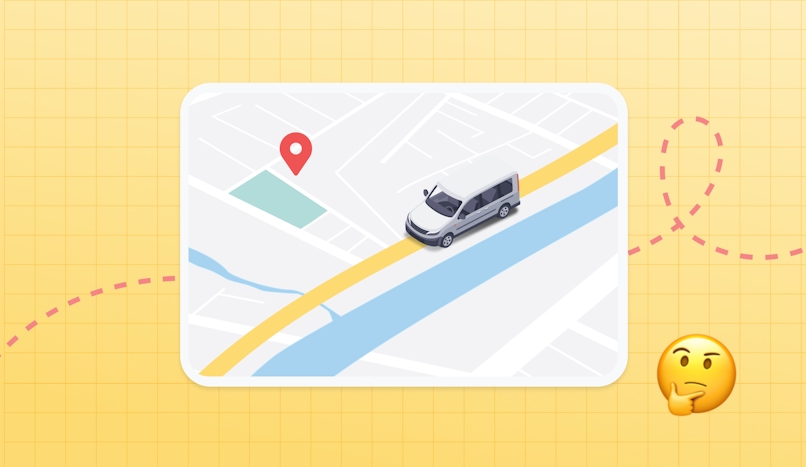
Keeping up with the major players in last-mile logistics is easier said than done!
Whatever type of product you’re transporting — whether it’s legal documents, restaurant meals, groceries, or retail products — you have to face one harsh truth: that last mile of the delivery process is usually the most expensive one.
According to some estimates, the ultimate stage of the delivery process — getting the package to its final destination — makes up 53% of overall shipping costs. Yikes!
There are a number of reasons for the high price tag, which we’ll get into in greater detail below.
To start, though, let’s talk about some of the general hurdles that can complicate last-mile logistics.
First, there’s the sheer volume of packages to be delivered in the last mile. When a shipping container has 1,000 items to deliver, it brings them from one port to the next, dropping all the items at once in a simple A-to-B process.
But when it comes to last-mile delivery, a lot of smaller packages have to be dropped at many different destinations. It’s not A to B. It’s A to B, C, D, E, F, G, H ... well, you get the idea.
This means more stops and complicated routes, resulting in more time on the road and more time idling between drop-offs. The sheer volume of stops needed also means retailers, distributors, and warehouses need more vehicles, with multiple delivery drivers and many vehicles.
This can also ramp up the complexity and the likelihood of confusion. More vehicles also mean more vehicle maintenance.
Then, there’s the innately challenging nature of getting a package into a customer’s hands. For packages that need proof-of-delivery, the driver might need more time.
This further increases the risk of delivery failure — for example, a customer isn’t home to receive the item.
Again, this isn’t the kind of issue you’ll face when it comes to earlier stages in the supply chain.
When a ship shows up at a port, all it has to do is dock. It doesn’t have to call or text a customer trying to chase them down or ask them where a safe drop-off point for a package is.
The challenges of last-mile delivery
As you can see, last-mile delivery companies face many obstacles, all of which can contribute to the cost of this final stage in the logistics process.
Here’s a quick rundown of the impact on last-mile delivery costs:
- Fuel inefficiency: Fuel can be a huge cost for last-mile delivery. Delivery vehicles don’t just get on the highway and drive straight through. They need to stop, start, and stand idle a lot, resulting in poor fuel efficiency — and more money spent on gas.
- Wasted manpower hours: The nature of delivery driving also means that vehicles spend a lot of time sitting idle — for example, they’re stuck at traffic lights or in traffic jams. Idling vehicles mean wasted manpower, as you have to pay drivers for essentially doing nothing.
- Repeated delivery attempts: If delivery fails the first time, your driver will have to return and fulfill the delivery a second or even a third or fourth time! Deliveries can fail for many reasons, from mistaken addresses to failing to give customers time delivery windows. This further wastes people power and needs additional fuel usage — meaning more money down the drain.
- Inefficient delivery routing: Inefficient delivery routes can be the icing on the cake. Routes that take drivers longer than necessary waste fuel and people power. Routes that aren’t well-planned can also increase the risk of repeated deliveries. Suppose a customer expects their package at 9:30 a.m., but your driver’s route results in delays, and they don’t make it until 10:15 a.m., then the customer may no longer be available.
Issues with last-mile delivery can also hurt your company’s bottom line (not just in terms of logistics costs). For example, if packages are often lost or delayed, customers may get annoyed and no longer remain loyal to your company, resulting in a shrinking customer base and decreased profits.
How to improve and profit on in-house last-mile deliveries
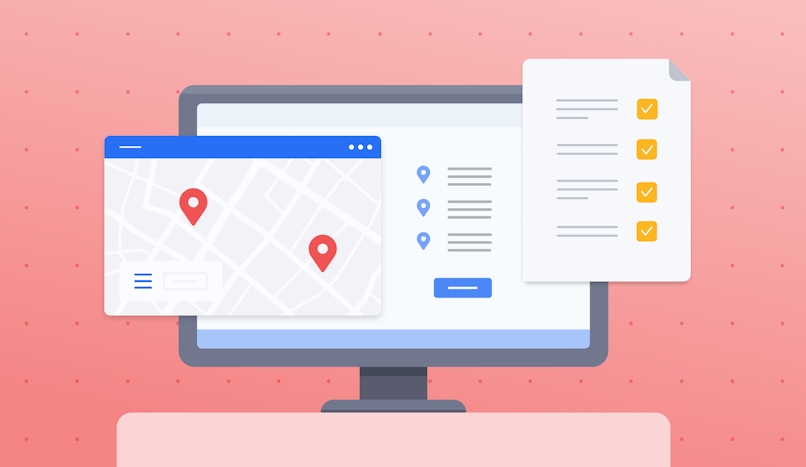
Enough talk about the challenges of last-mile delivery. Let’s talk about how you can overcome them.
The good news? Modern technology makes logistics a lot easier.
Here’s how you can harness cutting-edge tools to improve in-house last-mile delivery (and, hopefully, boost your profits).
- Optimize your drivers’ routes. Assigning clear routes to drivers allows them to find the fastest path to customers’ front doors. A multi-stop route planner can do the job for you. With a tool like Circuit for Teams, you can upload an Excel document with delivery details like the customer’s name and address and let the route planner find the fastest way to hit all the stops.
- Track deliveries effectively. Effective last-mile logistics needs more than simply loading packages into a driver’s truck, sending them on their way, and hoping for the best. You want to track packages in real time to address bottlenecks fast and alert customers accordingly. Circuit for Teams can help here, too, allowing you to track multiple drivers’ routes in real time.
- Keep customers updated. Customers want to know when to expect their packages. Giving updates on the delivery status, for example, by email or text message, is critical (and decreases the odds of a failed delivery and additional delivery attempts). Tools like Circuit for Teams allow you to update customers in this way.
- Simplify package finding. Delivery drivers often have hundreds of packages in a single truck. This can mean more idling and wasted time as they struggle to find a specific package at a specific stop. Things like scannable barcodes and a package finder feature can help cut down on this time waste (and save drivers stress, keeping them happy and performing their best).
- Confirm delivery success. Being able to confirm a package’s delivery protects drivers and companies. It can also bring customers peace of mind. There are various ways to do this, for example, by having the driver take a picture of a dropped-off package or having them obtain a customer’s signature. Again, routing software like Circuit for Teams can help.
Why is route optimization critical for last-mile deliveries?
Ultimately, improving route optimization is one of the most significant steps you can take to better your last-mile logistics!
By giving your drivers more efficient routes, you allow them to get their deliveries done with greater speed and accuracy.
Faster and better-organized routes mean less money wasted on fuel (for example, because a driver needs to double-back to hit a stop they missed). More efficient routing also reduces wasted people power.
Speedier routes can even enhance your company’s bandwidth. Drivers who complete their stops more quickly can take on more deliveries, allowing you to get more out of your workers and giving them the option to make more money.
By giving your drivers the tools they need to get their work done faster, you’re also making their overall work easier. Drivers will appreciate being able to get the job done with minimal hassle.
For example, modern routing software like Circuit for Teams connects to mapping tools, like Google Maps. You can help drivers avoid nuisances (and time-wasters) like traffic jams by synching these technologies.
Route optimization also makes it easier to set delivery time windows. Once a full delivery route is charted, a tool like Circuit for Teams can anticipate when a driver will make it to a stop.
Customers can then get an idea of when their packages will arrive. If a signature is needed, they can make sure they’re around to sign for it, saving the driver the stress of tracking them down.
Customers also appreciate the convenience of real-time updates. Plus, by allowing you to give an estimated time of arrival, there’s less chance of a delivery failing — minimizing the need for costly second or third attempts.
Discover how Circuit maximizes last-mile delivery profits
Route optimization can impact many components of last-mile delivery, ultimately resulting in a better organized, more streamlined, and faster process.
If you’re an e-commerce retailer, warehouse ops manager, or distribution center dispatcher, this can benefit your drivers, your customers — and your business as a whole.
In the past, route optimization was a complex process. Dispatch managers might chart routes manually.
Modern technology like Circuit for Teams makes it way easier. You simply upload the essential information (customer names and addresses) into the software, and it creates the routes for you.
It’s a zero-headache process!
Circuit for Teams is also handy for drivers, the optimization tool’s end user. Your drivers can access the route planner easily by a mobile app, tracking their progress in real time. They can even add or delete stops as needed, and the tool will update the route for them.
Circuit also allows you to prioritize deliveries. For example, if you have a next-day or same-day delivery, this can be noted in the app for ultra-fast delivery.
When using Circuit for Teams, drivers also enjoy many other perks, like proof-of-delivery, delivery notes, and a package finder. All of this adds to happier drivers, which leads to better service and satisfied customers.


